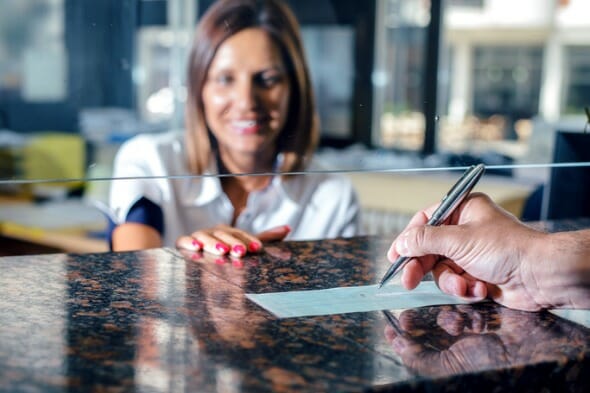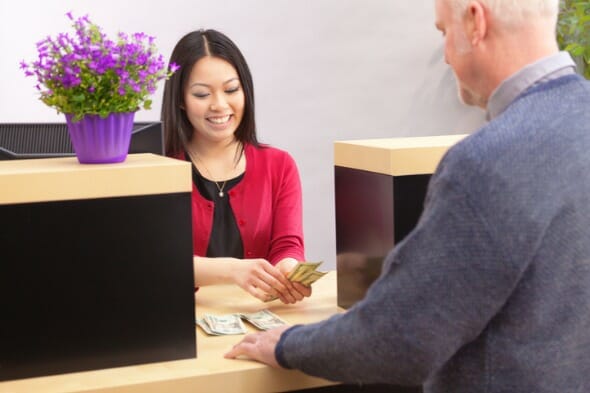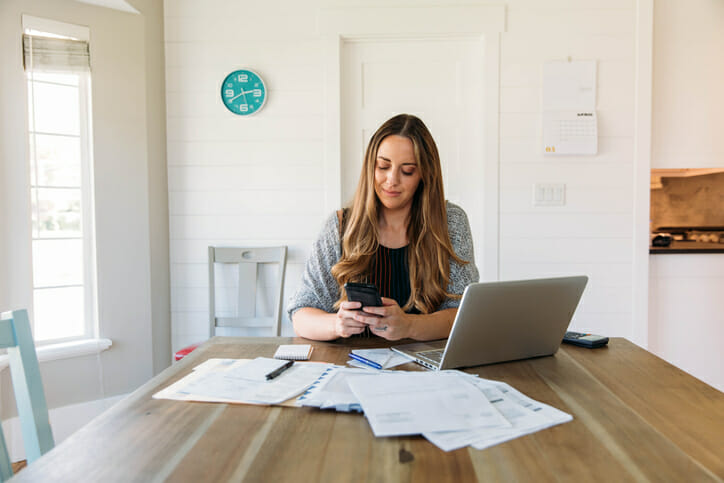

At some point, you may end up receiving money in the form of a check. This could be your paycheck, your tax refund or a personal check from a friend. Unlike cash, you can’t turn around and spend the check on a purchase immediately. However, no matter where the check comes from, cashing it is an easy process. This gives you more immediate access to cash than depositing the check. Read on to learn how and where to cash a check.
There are two major types of checks: business checks and personal checks. Business checks are issued by businesses, like your employment paycheck or payments from your insurance company. Personal checks are written by an individual, like a check your grandmother gives you for your birthday. Generally, it is much easier to find locations that will cash business checks than will cash personal checks. Personal checks run the risk of being written from an account without enough money in it. This results in the check bouncing, meaning you cannot cash it.
Other common types of checks include cashier’s checks. These checks contain guaranteed funds linked to a bank’s own account. Other guaranteed options include certified checks.
You can cash your check in a number of places. But before we get into that, it’s important to know what you’ll need first. For starters, you will need to provide photo ID when you go to cash a check. This ensures that the check is definitely meant for you. Then, no matter where you cash your check, you must endorse it. On the back, you’ll see a line with an “X.” This is the endorsement line, where you sign the check to show you accept it. For safety, don’t sign the check until you are ready to deposit or cash it. It helps even more if you sign it in front of your bank teller or whoever will cash it for you.
You also have the option of depositing the check into your checking or savings account. In this case, you would still sign the back of your check, but you will also write in your account number and “For deposit only” above your signature. You can then either immediately withdraw some funds or request that amount with your teller. You can do this by also filling out a deposit slip, where you provide your account number, the check number (typically found in one of the top corners of the check) and the amount of the check.
If you would like to receive cash back immediately from the check, write the amount you want to receive on the deposit slip as well, in the “debits” or “less cash” section, and subtract it from the amount of the check for the total deposit. Note that you may not be able to receive all of the funds from the check that same day, as the bank may have to wait for the check to clear the checkwriter’s account.

The simplest place to cash a check is at the bank. You can cash (or deposit) the check at your own bank. But you can also cash it at the bank that issued the check, too.
To truly cash a check at your bank, as opposed to depositing it and making a withdrawal, you will need to do so in person with a bank teller. Again, make sure to bring photo ID and your debit card. There, you can usually receive a larger amount of money than depositing the check with your smartphone or at an ATM. If the check bounces, however, not only will you not get the money, but your bank may charge you a returned check fee.
If you go to the issuing bank to cash the check, you can usually receive the entire amount. This is because the bank has more immediate access to the account being drawn from for the funds. You may face a fee if you don’t have an account, like a checking account, with this bank. Also, if the account in question does not have sufficient funds to cover the check, the issuing bank does not have an obligation to give you the entire amount.
Cashing a check at the issuing bank is probably your best bet if you don’t have a bank account. Don’t forget that you’ll need photo ID and that you may have to pay a fee, either a flat rate (like $5) or a percent of the check amount (like 1%). It may be a good idea to open a checking account if you can, especially if you’ll be receiving more checks in the future. Luckily, there are a number of free checking accounts that make it easy to open and own one.
Major retailers can also cash checks, including stores like Walmart, 7-Eleven, Kmart and certain supermarkets. A drawback here is that many stores may only cash business and payroll checks, not personal checks. Either way, there will still be a fee, although it’s typically minimal. For example, Kmart charges up to $1 while Walmart charges $3 on checks of $1,000 or less and $6 for checks larger than that. You likely won’t face a check cashing fee over $10.
There are stores that specialize in check cashing. These stores will cash nearly any check you bring them, but they charge hefty fees for this service. Some fees can be up to 10%. For large checks, these fees can get costly. This means you can end up paying a $100 fee for a $1,000 check!
Finally, you can choose to deposit the check to a prepaid card account. Prepaid cards are linked to pre-funded debit accounts and don’t require a bank account to use. If your prepaid card is linked to a bank, you can use the bank’s ATM to deposit your check into your account. Some prepaid cards also offer apps that allow you to deposit the check virtually with a picture.

If you have a check you need to cash, you have many options to do so. The best way is to cash or deposit the check with your bank. That allows you to avoid hefty fees and gives you have access to all or some of the money more immediately. Without a bank account, you’ll likely have to pay a fee to cash a check at the issuing bank, major retailers, check-cashing stores or into a prepaid debit card account. Wherever you cash your check, don’t forget to bring your photo ID and to endorse the check right before you cash it.
Photo credit: ©iStock.com/dardespot, ©iStock.com/YinYang, ©iStock.com/PhotoInc
Danielle KlimashouskyDanielle Klimashousky is a freelance writer who covers a variety of personal finance topics for SmartAsset. She is an expert on topics including credit cards and home buying. Danielle has a BA in English from Wesleyan University.
Read More About Checking Account



More from SmartAsset
SmartAsset Advisors, LLC ("SmartAsset"), a wholly owned subsidiary of Financial Insight Technology, is registered with the U.S. Securities and Exchange Commission as an investment adviser. SmartAsset's services are limited to referring users to third party advisers registered or chartered as fiduciaries ("Adviser(s)") with a regulatory body in the United States that have elected to participate in our matching platform based on information gathered from users through our online questionnaire. SmartAsset receives compensation from Advisers for our services. SmartAsset does not review the ongoing performance of any Adviser, participate in the management of any user's account by an Adviser or provide advice regarding specific investments.
We do not manage client funds or hold custody of assets, we help users connect with relevant financial advisors.
This is not an offer to buy or sell any security or interest. All investing involves risk, including loss of principal. Working with an adviser may come with potential downsides such as payment of fees (which will reduce returns). There are no guarantees that working with an adviser will yield positive returns. The existence of a fiduciary duty does not prevent the rise of potential conflicts of interest.